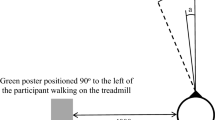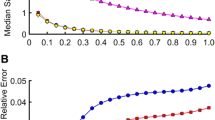Abstract
The aim of this study was to evaluate the hypothesis that an individual’s preferred or usual walking speed, step length and cadence optimize the stability of head and pelvic accelerations in vertical (V), anterior–posterior (AP) and medio-lateral (ML) planes when walking. Acceleration patterns of the head and pelvis were recorded in ten healthy young adults as they walked on a level surface in three separate experiments: (1) walking at five different speeds, ranging from very slow to very fast; (2) walking in time to a metronome set at five different cadences, ranging from 33 to 167% of subjects’ usual cadence; and (3) walking at five different step lengths varying from very short to very long while keeping in time with a metronome set at cadences 67, 100 and 125% of usual cadence. The results indicated that acceleration patterns in the V and AP planes were most stable when subjects walked at their usual cadence and step length. In the ML plane, stability was suboptimal, but still adequate, with the usual cadence and step length. The findings suggest that healthy young people walk in a manner that maximizes V and AP stability while maintaining adequate, though suboptimal ML stability.





Similar content being viewed by others
References
Bauby CE, Kuo AD (2000) Active control of lateral balance in human walking. J Biomech 33:1433–1440
Brach JS, Berthold R, Craik R, VanSwearingen JM, Newman AB (2001) Gait variability in community-dwelling older adults. J Am Geriatr Soc 49:1646–1650
Cavagna GA, Saibene FP, Margaria R (1963) External work in walking. J Appl Physiol 18:1–9
Cavagna GA, Thys H, Zamboni A (1976) The sources of external work in level walking and running. J Physiol 262:639–657
Finley FR, Cody KA, Finizie RV (1969) Locomotion patterns in elderly women. Arch Phys Med Rehabil 50:140–146
Finley FR, Cody KA (1970) Locomotive characteristics of urban pedestrians. Arch Phys Med Rehabil 51:423–426
Frenkel-Toldeo S, Giladi N, Peretz C, Herman T, Gruendlinger L, Hausdorff JM (2005) Effect of gait speed on gait rhythmicity in Parkinson’s disease: variability of stride time and swing time respond differently. J Neuroengineering Rehabil 2:23
Gabell A, Nayak US (1984) The effect of age on variability in gait. J Gerontol 39:662–666
Grabiner PC, Biswas ST, Grabiner MD (2001) Age-related changes in spatial and temporal gait variables. Arch Phys Med Rehabil 82:31–35
Guimaraes RM, Isaacs B (1980) Characteristics of the gait in old people who fall. Int Rehabil Med 2:177–180
Helbostad JL, Moe-Nilssen R (2003) The effect of gait speed on lateral balance control during walking in healthy elderly. Gait Posture 18:27–36
Hirasaki E, Moore ST, Raphan T, Cohen B (1999) Effects of walking velocity on vertical head and body movements during locomotion. Exp Brain Res 127:117–130
Keshner EA, Cromwell RL, Peterson BW (1995) Mechanisms controlling human head stabilization. II. Head-neck characteristics during random rotations in the vertical plane. J Neurophysiol 73:2302–2312
Maki BE (1997) Gait changes in older adults: predictors of falls or indicators of fear. J Am Geriatr Soc 45:313–320
Menz HB, Lord SR, Fitzpatrick RC (2003a) Acceleration patterns of the head and pelvis when walking on level and irregular surfaces. Gait Posture 18:35–46
Menz HB, Lord SR, Fitzpatrick RC (2003b) Acceleration patterns of the head and pelvis when walking are associated with risk of falling in community-dwelling older people. J Gerontol A Biol Sci Med Sci 58:M446–452
Menz HB, Lord SR, Fitzpatrick RC (2003c) Age-related differences in walking stability. Age Ageing 32:137–142
Menz HB, Lord SR, St George R, Fitzpatrick RC (2004a) Walking stability and sensorimotor function in older people with diabetic peripheral neuropathy. Arch Phys Med Rehabil 85:245–252
Menz HB, Latt MD, Tiedemann A, Kwan MMS, Lord SR (2004b) Reliability of the GAITRite walkway system for the quantification of temporo-spatial parameters of gait in young and older people. Gait Posture 20:20–25
Moe-Nilssen R, Helbostad JL (2005) Interstride trunk acceleration variability but not step width variability can differentiate between fit and frail older adults. Gait Posture 21: 164–170
Murray MP, Kory RC, Clarkson BH, Sepic SB (1966) Comparison of free and fast speed walking patterns of normal men. Am J Phys Med 45:8–23
Ralston HJ (1976) Energetics of human walking. In: Herman RM, Grillner S, Stein PSG, Stuart DG (eds) Neural control of locomotion. Plenum, New York, pp 77–98
Sekiya N, Nagasaki H, Ito H, Furuna T (1997) Optimal walking in terms of variability in step length. J Orthop Sports Phys Ther 26:266–272
Smidt GL, Arora JS, Johnston RC (1971) Accelerographic analysis of several types of walking. Am J Phys Med 50:285–300
Smidt GL, Deusinger RH, Arora J, Albright JP (1977) An automated accelerometry system for gait analysis. J Biomech 10:367–375
Waters RL, Lunsford BR, Perry J, Byrd R (1988) Energy–speed relationship of walking: standard tables. J Orthop Res 6:215–222
Wolfson L, Judge J, Whipple R, King M (1995) Strength is a major factor in balance, gait, and the occurrence of falls. J Gerontol A Biol Sci Med Sci 50:64–67
Yack HJ, Berger RC (1993) Dynamic stability in the elderly: identifying a possible measure. J Gerontol 48:M225–M230
Yamasaki M, Sasaki T, Torii M (1991) Sex difference in the pattern of lower limb movement during treadmill walking. Eur J Appl Occup Physiol 62:99–103
Acknowledgments
This project was funded by the National Health and Medical Research Council (NHMRC) Partnerships Grant: Prevention of Injuries in Older People (ID: 209799) and an NHMRC Project Grant (ID: 980232). Prof Lord is currently NHMRC Senior Principal Research Fellow, and A/Prof Menz is currently NHMRC Clinical Research Fellow (ID: 433049).
Author information
Authors and Affiliations
Corresponding author
Rights and permissions
About this article
Cite this article
Latt, M.D., Menz, H.B., Fung, V.S. et al. Walking speed, cadence and step length are selected to optimize the stability of head and pelvis accelerations. Exp Brain Res 184, 201–209 (2008). https://doi.org/10.1007/s00221-007-1094-x
Received:
Accepted:
Published:
Issue Date:
DOI: https://doi.org/10.1007/s00221-007-1094-x




